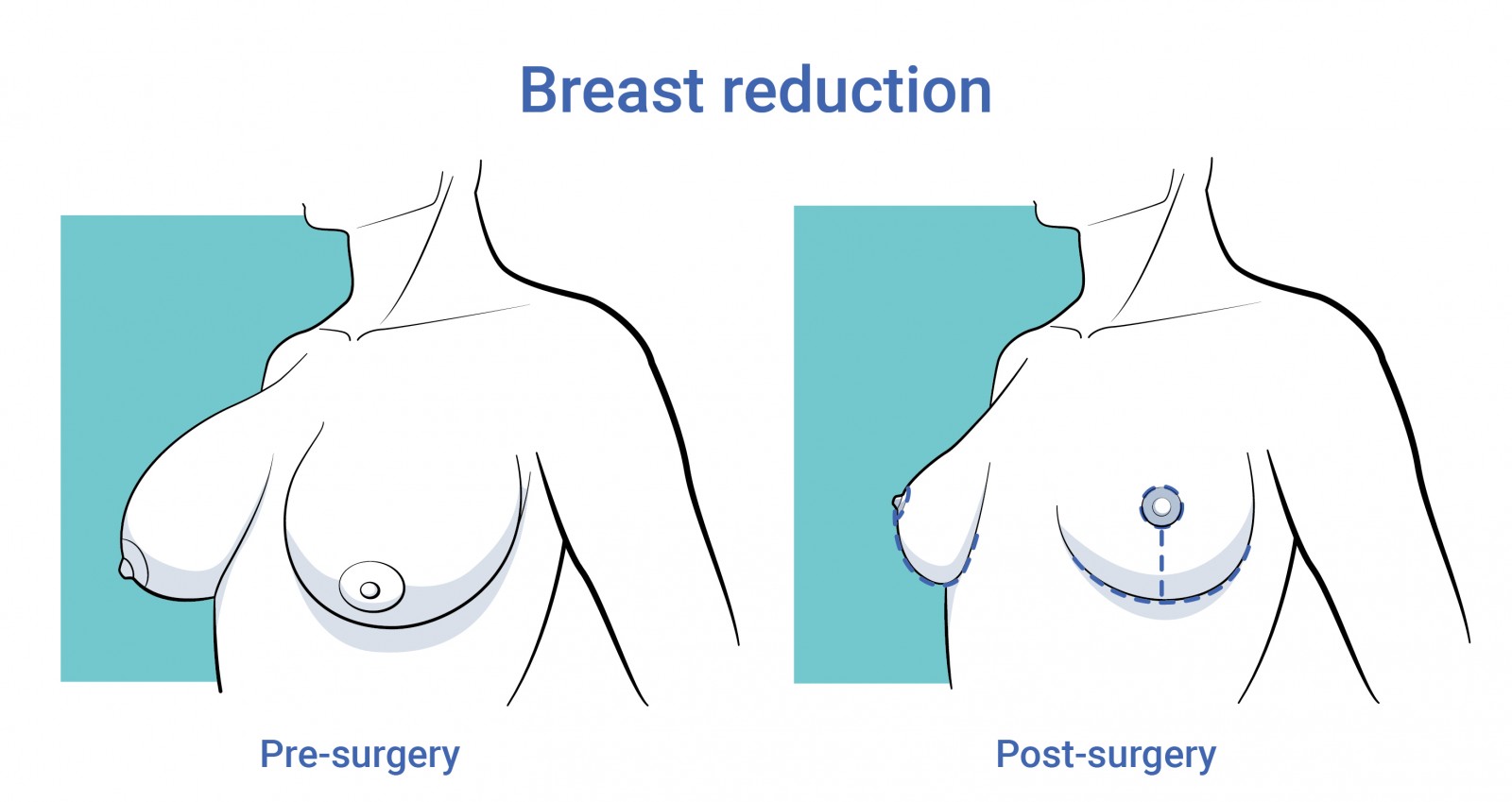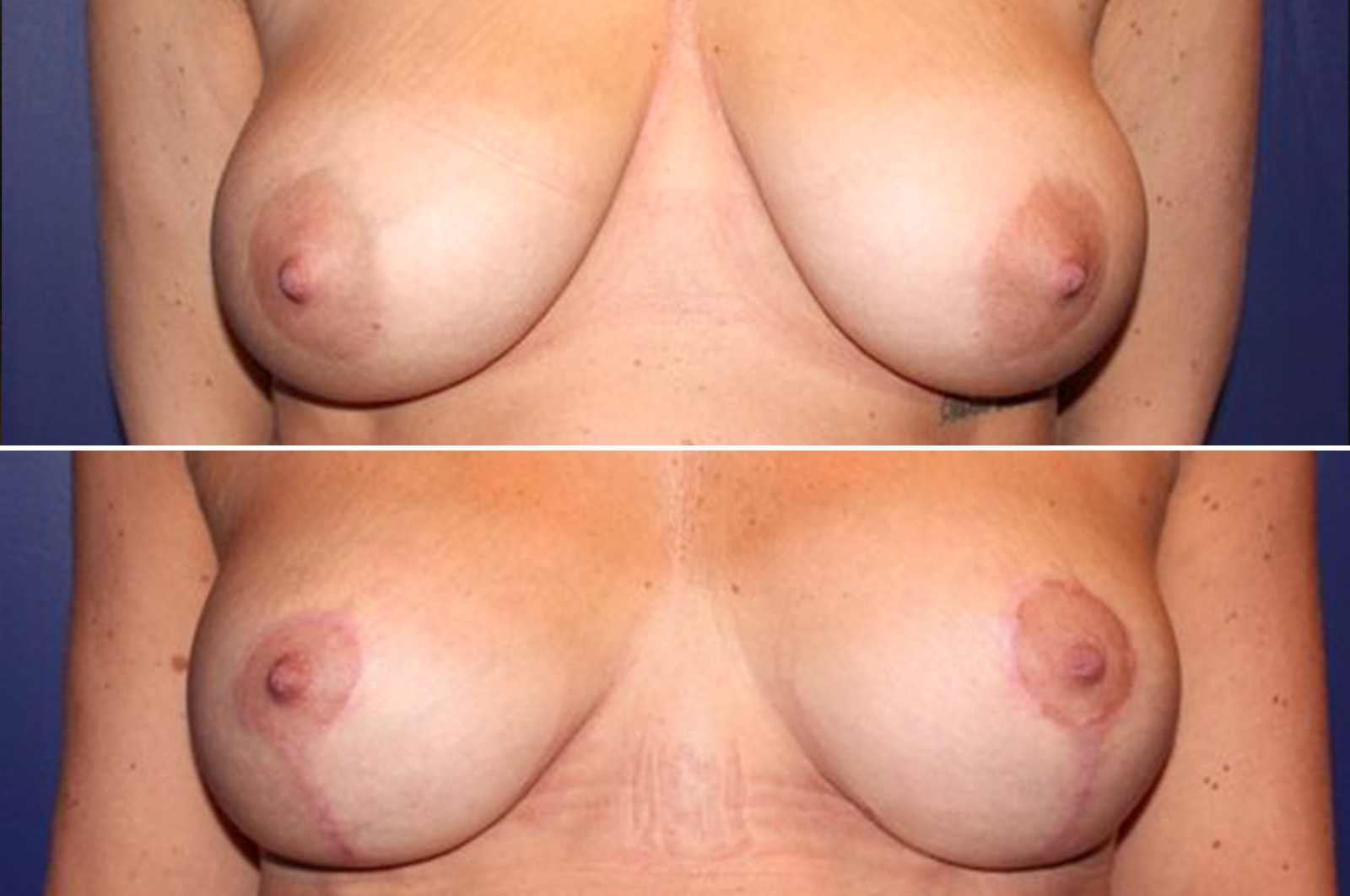Breast reduction
Table of contents:
What is a breast reduction?
Puberty, hereditary factors, your weight, pregnancy or breastfeeding can cause your breasts to enlarge. Not only can they droop when the skin loses its elasticity, but they also cause certain neck, shoulder and back problems over time. The aesthetic aspect can also have a negative impact on your self-confidence.
During a breast reduction, excess fat, glandular and skin tissue is removed to reduce and reshape your breasts. As a result, they will fit your body better and may be less noticeable because of their new size.
Because your breasts are reshaped and tissue is removed, this procedure is often combined with a breast lift.

Procedure - How does a breast reduction work?
- During a consultation, your surgeon will draw up your treatment plan with you. During that session, you will determine together what your expectations are, what the possibilities are, etc.
- Before the surgery, the surgeon will make the necessary marks on the skin. You will then be put under general anaesthesia and the procedure will take 2 to 3 hours on average.
- Depending on the size and shape of your breasts, the surgeon will tailor the operation technique based on your treatment plan. Your personal wishes for the final result also play an important role.
- In one of the most common techniques, three incisions are made in the breast during the procedure: around the areola, vertically downwards from the lower edge of the areola and horizontally in the natural curve. This method is also called the anchor method (after the shape of the scar). The breast is then "rebuilt".
- After the procedure, you will have an anchor scar on each breast:
- 1 in the natural skin fold below the breast.
- 1 from the centre of the skin fold running vertically to the nipple
- 1 around the nipple
- Our surgeon will do everything possible to keep these to a minimum. After your recovery, the scars in the inframammary fold and around the areola will be barely visible. The part that runs vertically from the inframammary fold to the nipple fades slightly but remains visible.
- The plastic surgeon will do everything possible to keep the scars as subtle as possible.

Advantages
- Your breasts will be less large, feel less heavy and have a nicer shape. They will also be lifted.
- Because your breasts are less heavy, possible back, neck and shoulder pain will be reduced. This makes sports or other physical activities considerably more pleasant. Cutting or pressing bra straps will also be reduced.
- Your areola is adjusted so that it is in proportion to the rest of your breast.
- You will be able to find and try on clothes and lingerie more easily.

Disadvantages or complications
It is a major surgery that may involve certain risks and complications. Open communication during the consultation about your medical history, medication use and lifestyle is therefore very important. Only in this way can we reduce possible risks to an absolute minimum.
Possible complications are:
- Infection
- Wound dehiscence (opening of the wound along the incision line)
- Haematoma (an accumulation of blood under the skin that may require removal)
- Negative reaction to anaesthetics
- Delayed wound healing
- Post haemorrhage
- Nipple necrosis
- Fat necrosis
- Seromas (accumulation of wound fluid)
- Asymmetry
- Nipple and skin sensation disturbances and/or changes, possibly permanent
- Permanent scars
- Damage to underlying structures
- Allergic reactions to tapes, sutures and plasters
- Pain
- Unsatisfactory aesthetic result.
- Breastfeeding can be more difficult or even impossible after a breast reduction.
- We recommend that you stop smoking before the operation. Patients who smoke or use tobacco products or nicotine products (such as nicotine patches and chewing gum) at the time of surgery have an increased risk of complications such as skin necrosis and impaired wound healing.
Recovery - How do you prepare for a breast reduction?
- After your breast reduction you should stay overnight at the o2 clinic. After your surgery, you will be closely monitored in the recovery department. If all goes well, you will then be taken to your room for the night. You will not be able to go home until the next day, after the surgeon's approval and under supervision.
- You will need to purchase a sports bra in advance. It is important that you wear the sports bra day and night for six weeks.
- We recommend that you arrange transport when you go home. Driving a car yourself will not be possible and is strongly discouraged to avoid complications.
- For the first 24 hours, your breasts will feel stiff, sore and tense. There may also be congestion. This is because the skin has to adjust to the new size of the breast. Naturally, you will be given painkillers for this. This feeling will gradually diminish as you recover.
- You will have bruising and your scars may be red and swollen. This will take a few weeks to a few months until it subsides or fades.
- Avoid strenuous exercise, sports activities and the like for the first 2 months.
- As soon as the wound has closed and the scabs have disappeared, you can start applying the scar cream. Do this twice a day on the closed wound; this will increase the chance of the skin healing nicely. Avoid direct sunlight or use a sun screen with a high degree of protection (e.g. SPF 50).
- The discomfort can last up to several months. It usually takes up to a year and a half for your scars to settle down. Patience and good aftercare are therefore crucial.
Frequently asked questions
What is the cost of body surgery?
You can find estimated prices here, after your consultation you will be informed of the exact prices of your operation. Prices are average and may vary depending on: the exact treatment or surgery needed; the exact area you want to have treated; your body type; your expectations and wishes...
We have a specific procedure to get a quote from the doctor. To receive a personalized quote, please visit the following link to see your different options.
Is there a payment plan or financing option for a surgery?
No, payments have to be made following our payment policy. It is not possible to pay for a surgery via monthly/... payments.
What is the cost of a breast lift?
You will find all the prices of our treatments and operations here.
How long does the result of a breast lift last?
It may take several weeks or even months before you see the final result of your breast uplift. The final result will of course last for several years. If protheses have been used, keep in mind that they have an expiration date.
What are the risks of a breast lift?
Any disadvantages or possible complications can be found here.
Who is a suitable candidate for a breast lift?
A breast uplift can help if you suffer from drooping or sagging breasts after pregnancy, breast feeding, weight gain or loss, ageing etc.
What is the cost of a breast reduction?
You will find all the prices of our treatments and operations here.
How long does the result of a breast reduction last?
It can take several weeks or even months before you see the final result of your breast reduction. The final result naturally remains for several years.
What are the risks of breast reduction?
All disadvantages or possible complications can be found here.
Who is a suitable candidate for a breast reduction?
A breast reduction can help if you suffer from heavy, drooping breasts after pregnancy, breast feeding, weight gain, becoming older, etc. Especially if you suffer from neck, shoulder and back pains, this procedure can bring relief.
What is the difference between a nipple correction and a nipple-areola correction?
With a nipple correction, mainly the shape of the nipple is adjusted. The areola correction involves reducing the size of the areola.
What is the cost of a nipple correction?
You will find all the prices of our treatments and operations here.
How long does the result of a nipple correction last?
Normally the result is permanent, although scars may remain slightly visible.
What are the risks of a nipple correction?
Any disadvantages or possible complications can be found here.
Who is a suitable candidate for a nipple correction?
A nipple correction aims to restore the proportions between the breast, the nipple and the areola. When a nipple has a deviant shape and is, for example, (too) large or retracted, a nipple correction may be necessary or desirable. Also when the areola (the dark area around the nipple) is too large in proportion, this can be surgically corrected.
We are doing our very best to keep this information up-to-date. In case you see anything that no longer seems accurate, or in case you have a question, please fill out the form below.
